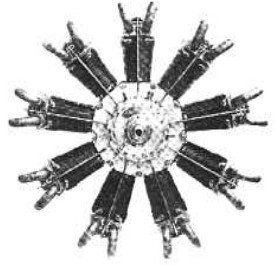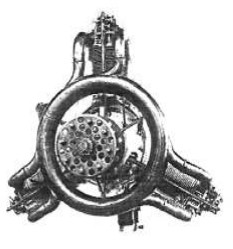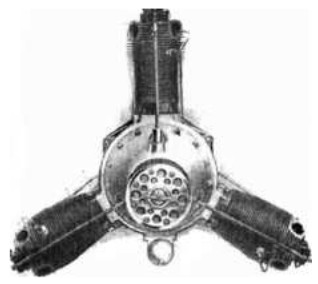Updated: 13-Feb-2020
The Jupiter 450 hp, radial, 9-cylinder Cosmos engine was mounted on the 1919 Sopwith "Schneider". There was the Jupiter and the Jupiter II and III series.
-Cosmos' factory was Brazil-Straker with its engineer, Roy Fedden (early in his career).
-Knowing the Argyll system, he began planning the 1000 hp Hercules engine with the Argyll sliding-sleeve system, although he first made the Perseus in Bristol.

"Cosmos Jupiter"
-The Cosmos factory failed and entered the orbit of Bristol Airplane Co. in 1920.

"Cosmos Lucifer"
-The Cosmos Lucifer had 3 cylinders of the same size as the Jupiter and gave 120 hp.
-The difference between the Jupiter and the II series is that the latter used gear to give 500 hp at 2,000 rpm. The Jupiter shown above used three Claudel HC8 carburetors in battery on the lower part.
-The 14-cylinder, double row, Mercury radial engine gave 350 hp at 2,000 rpm. It had two duplex Ware carburetors, and also two intake valves and two exhaust valves per cylinder. There is also a three-carburetor version.

"Cosmos Mercury"

"Cosmos on a Bristol aircraft"
-At the 1919 Paris Air Show the 450 hp Cosmos Jupiter engine was presented.
-This engine would have an excellent future later in Bristol.
From Appendix 10: Pioneering company in radial engines. It was absorbed by Bristol and its projects as Jupiter, Mercury and Lucifer passed to that company along with its chief engineer (Roy Fedden). We got hold of an illustration of an original Cosmos engine. Notice the single lever and the two exhaust outlets on the front.

"Lucifer de Cosmos hacia 1920"
Engines of COSMOS
Model: Jupiter, II, III
Arquitecture: 9-cylinder Radial
Cooling:
Total Displacement:
Bore / Stroke:
Power: 450 HP @ rpm
Weight:
The difference between the Jupiter and the II series is that the latter used gear to give 500 hp at 2,000 rpm. The Jupiter shown above used three Claudel HC8 carburetors in battery on the lower part.

"Cosmos Jupiter"
Model: Lucifer
Arquitecture: 3-cylinder Radial
Cooling:
Total Displacement:
Bore / Stroke:
Power: 120 HP @ rpm
Weight:
The Cosmos Lucifer had 3 cylinders of the same size as the Jupiter.

"Cosmos Lucifer"
Model: Mercury
Arquitecture: 14-cylinder Radial
Cooling:
Total Displacement:
Bore / Stroke:
Power: 350 HP @ 2000 rpm
Weight:
It had 14 cylinders in two rows, and two duplex Ware carburetors, and also two intake valves and two exhaust valves per cylinder. There is a three-carburetor version as well.

"Cosmos Mercury"


